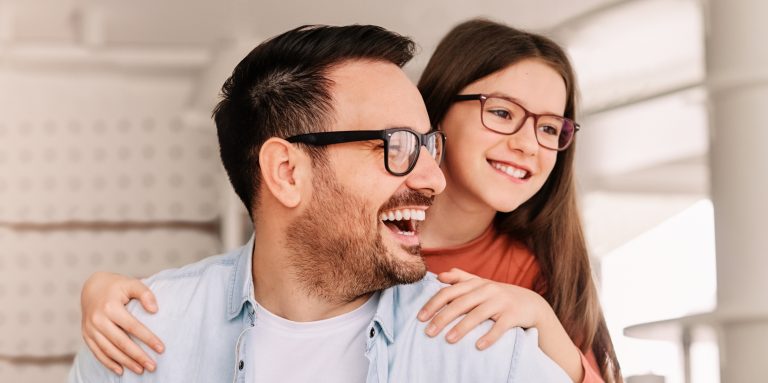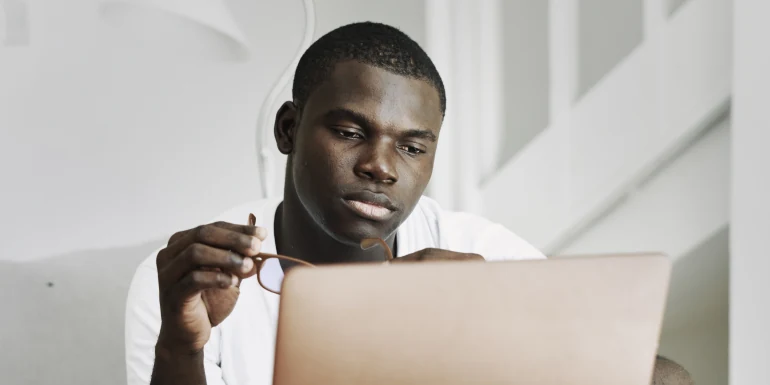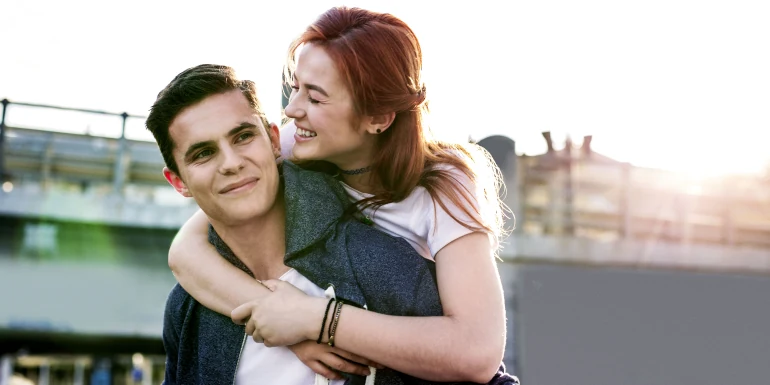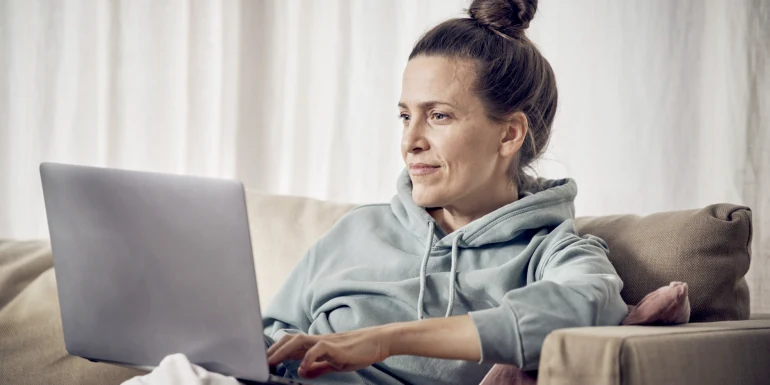Children’s glasses and contact lenses for adolescents
Does your child need glasses? If so, you might be asking yourself questions like: who covers the costs? Is an eye test with an optician sufficient? Are contact lenses suitable for adolescents? Plus, how do you keep your eyes healthy?

Vision problems are nothing to do with age: they can occur at any time. If children and young people have difficulty seeing, it can affect their development. Since children’s eyes grow with them, regular check-ups and observations are important.
Vision issues in children and teenagers can manifest themselves in symptoms such as headaches, difficulties and getting tired quickly while reading, writing and using a screen. Motor problems and restlessness can also occur. An ophthalmologist or an orthoptist can check eyesight and visual perception.
Eye tests for children and adolescents
Young people should have their eyes tested by an ophthalmologist or an orthoptist. Although paediatricians examine the eyes from an early age as part of their usual routine check-ups, they cannot detect all visual impairments and defects.
How often is an eye test necessary?
Anyone who wears glasses should have an eye test annually. Young eyes grow and change, and so does visual acuity – especially in instances of short sightedness, where the eye grows too quickly and can only be stopped if the visual defect is corrected early. This is also the case where the eyes see with differing degrees of focus, prompting the brain to simply switch off the weaker eye. An early ophthalmological check-up can prevent this.
Children’s eye test – optician or ophthalmologist?
One ophthalmologist’s prescription per year is required for your health insurance company to co-finance children’s glasses or contact lenses. If another adjustment is made during the year, the eye test can also be carried out by an optician. Important: examining and treating vision and eye health fall within an ophthalmologist’s purview.
How much do children’s glasses cost? And what does health insurance pay for?
The costs depend on the type and specifications of the lenses, the correction and the desired model. Basic insurance pays CHF 180 per year towards the costs of spectacle lenses and contact lenses up to the age of 18, minus the co-payment. However, corrective glasses and lenses usually cost more than CHF 180, so it is well worth taking out supplementary insurance. The same applies when it comes to covering a second pair of glasses or extra contact lenses. Young people are particularly active – often breaking or losing things – so it’s good to have a spare pair of glasses to hand. And in most cases, they need corrective sunglasses, swimming goggles and ski goggles too.
Insurance for children’s glasses and contact lenses
Under basic insurance, children and young people receive CHF 180 per year towards the costs of spectacle lenses and contact lenses up to the age of 18. With COMPLETA supplementary insurance, 90% of the additional costs are insured, up to a maximum of CHF 300. COMPLETA PLUS covers further costs – including the costs of spectacle frames.
Typical visual defects in early years
Vision does not develop fully until the age of 12 or thereabouts. The sooner visual impairments are detected and treated, the greater the chances of them being stopped or remedied. Here’s an overview of the most common visual defects in children and adolescents:
Far-sightedness in children
Those with far-sightedness or hyperopia find it difficult to see things near them in focus. The young lens of the eye is still very elastic and compensates for this. In the case of more pronounced far-sightedness, focusing exerts great strain on the eye muscles. If they are constantly placed under great stress – for example, during intensive screen use – far-sightedness can lead to symptoms such as headaches, eye fatigue and dizziness.
Far-sightedness is not uncommon in younger children, but rare in adolescence. This is because congenital far-sightedness usually disappears by the time children start school due to the growth of the eye. Depending on the severity, far-sightedness in children should be corrected for as long as it persists. If left untreated, it can lead to lifelong visual impairment.
Short-sightedness in children
If a teenager or child is short-sighted, they can see things that are close to them but everything that is far away appears blurred. Short-sightedness in children often develops at the same time children start school: pupils start to do more close work, be it with notebooks, books or screens. This stimulates the eyeball to grow, which is how short-sightedness – also referred to as myopia – develops. It is additionally suspected that the use of mobile phones and tablets combined with less exercise and time outdoors encourages short-sightedness.
Astigmatism in children
In astigmatism, the cornea is unevenly curved: light rays do not hit the retina with pinpoint accuracy, and the image is distorted. The young brain compensates for this to a certain extent, which is why the visual impairment is not noticeable at first. Astigmatism also changes as an individual grows. If the child has trouble seeing clearly both near and far, this could be due to astigmatism. This may be associated with dizziness, headaches, difficulty concentrating, and squinting of the eyes.
If an ophthalmologist has detected severe astigmatism, glasses will help the child to learn to see correctly and clearly. In the case of far-sightedness and astigmatism combined, it’s often only the astigmatism that is corrected. Ongoing fine-tuning and regular ophthalmologist check-ups are necessary.
Squints in children
In the case of an obvious squint, the eyes do not look in the same direction. They don’t work together properly. This results in the squinting eye failing to develop optimum visual acuity and distorts spatial perception.
A hidden squint is where the individual has a tendency to squint, but not a constant squint. The brain compensates for this continuously. Only an ophthalmological examination can detect the vision problem. Glasses correct the visual defect. The weaker eye is trained by covering the better eye with a plaster, and this eye training corrects the squint.
An undetected hidden squint can suddenly lead to symptoms such as headaches, eye pain, squinting in one eye, impaired vision, sensitivity to light, rapid fatigue and a crooked head posture, or a previously compensated squint can become visible gradually. Even far-sighted children sometimes compensate for their visual defects by squinting in order to see clearly up close.
Lazy eye in children
This visual impairment, also known as amblyopia, usually occurs in the first few years of life. The vision of one or both eyes does not develop properly, which can lead to significant limitations. The most common form is squint amblyopia, where the eyes are misaligned. However, in some cases, there are no symptoms. Only a targeted examination by an ophthalmologist will reveal the visual defect.
Eye training for children
Eye training activates the eye muscles, making it easier to see. The eyes tire and strain less, which stops side effects such as burning eyes, headaches, neck pain or difficulty concentrating. Whether or not eye exercises also improve eyesight has yet to be scientifically proven. Six tips for healthy eyes:
1. Get a daily dose of fresh air and light
Sunlight is crucial to healthy eye development. Studies show that doing plenty of exercise in the fresh air has a positive impact on visual acuity.
2. Look into the distance
When the eyes are constantly focused on something close-up, it strains the eye muscles to the point of overexertion. Looking into the distance every 20 minutes, preferably into some greenery, can help.
3. Limit screen time
It’s not just staring at the screen that damages the eyes, so does its blue light: too much screentime accelerates the growth of the eyes, making them longer. This leads to short-sightedness.
4. Relax the eye muscles
Closing your eyes and taking a deep breath is a wonderful way to help the eye muscles relax. Gently massage your eyes to enhance the effect.
5. Focus your eyes
Close your eyes and alternate between “looking” to the left, right, up and down. Repeat ten times in each direction. Then repeat the same thing with your eyes open.
6. Blink more often
Blink quickly, keeping your eyes as relaxed as possible, for one minute. We often
Contact lenses: from what age are they suitable?
Generally, there is no mandatory minimum age for contact lenses. Many children and teenagers start wearing contact lenses between the ages of 12 and 14 – as soon as they are ready to use them independently.
From what age can you undergo laser eye surgery?
If glasses or contact lenses are too inconvenient for you, you may want to consider laser eye correction. But is laser eye surgery an option for children and teenagers? The procedure is only possible from the age of 18, but it is advisable to wait until the age of 20 – and only if eyesight remains the same for several years. If someone is short-sighted, their eyes can sometimes continue growing until they reach the age of 25.
Health insurance pays the following towards glasses and contact lenses
Does your child need glasses? Or would your teenager like to use contact lenses? Basic insurance pays up to CHF 180 per year for children and young adults up to the age of 19. Cover the shortfall with a supplementary insurance policy:
TOP
You will receive 90% of the cost of spectacle and contact lenses up to CHF 150 per calendar year.
COMPLETA
You will receive an additional 90% of the cost of spectacle and contact lenses up to CHF 300 per year.
COMPLETA PLUS
You will receive 90% of the remaining costs up to CHF 200 per year (including spectacle frames).
Articles about this topic
Do you have questions?
We're here to help.


